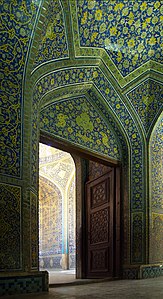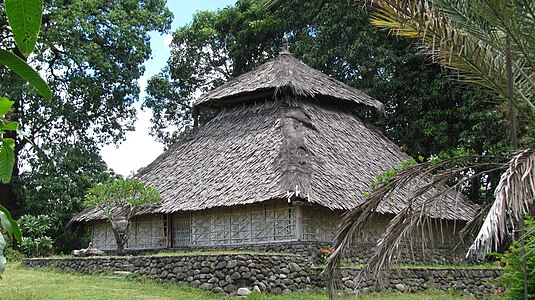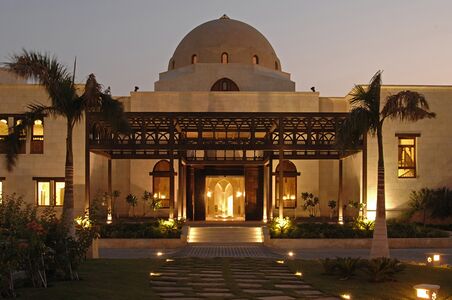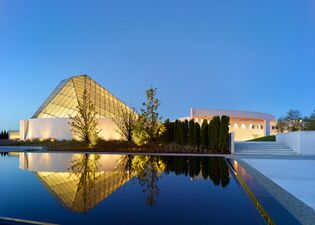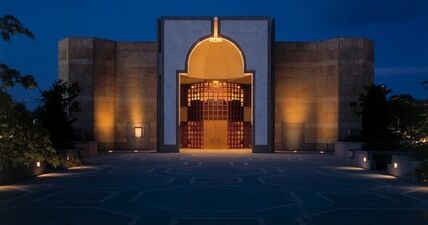Bayt al-Adhkar
| Part of a series on | |||||
| Esoteric Shi'ism | |||||
|---|---|---|---|---|---|
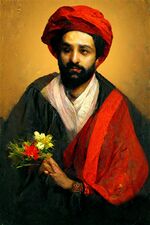 | |||||
| The Seven Figures | |||||
|
|||||
| The Seven Principles | |||||
|
|||||
| Beliefs and practices | |||||
| Place of worship | |||||
|
|||||
| Holy days | |||||
|
|||||
| Texts | |||||
| Governance | |||||
A Bayt al-Adhkar, or more commonly a House of Remembrance, is one of several types of Esoteric Shia places of worship, the others being the House of Sorrows (bayt al-ahzan) and the Mosque. Houses of Remembrance act as the focal point of Esoteric Shia religious life. An empty throne symbolising the spiritual authority of the Hidden Imam, ablution points where congregants may perform ablution to achieve ritual purity and an assembly hall in which congregants may recite the Fifteen Whispered Prayers and perform other rituals of remembrance, such as the dhikr and quiet meditation are all common features of a House of Remembrance.
Houses of Remembrance are divided into two types. A local House of Remembrance, which serves a commune in Hindia Belanda or entire cities outside Hindia Belanda, is headed by a Mualim. In Hindia Belanda, larger Houses of Remembrance are called Provincial Houses of Remembrance as they are often built to serve an entire province, although they are more accurately known as a "Bayt al-Adhkar al-Kabir". For this reason, Provincial Houses of Remembrance typically form a complex of building, often incorporating shrines, landscaped gardens, a visitor centre, an exhibition hall and other facilities, which may include educational institutes and a pilgrims' house. A Provincial House of Remembrance is led by a Panghoeloe, who is assisted by a number of Mualims. Outside Hindia Belanda, all Houses of Remembrance, irrespective of size, are classified as local Houses of Remembrance and are led by a number of Mualims, depending on size of the local congregation.
Unlike the traditional mosque, the House of Remembrance often features iconographies of the Islamic Prophet, his daughter Lady Fatima, the Twelve Infallible Imams and other Esoteric Shia holy figures. For this reason, the Canonical Prayers which are said thrice a day by Esoteric Shias are not to be performed in a House of Remembrance as the absence of visual imagery is one of its requirements. Many Houses of Remembrance, however, often include an additional prayer hall bereft of visual art set for this purpose whilst others are situated adjacent to a mosque to enable worshippers to fulfil their daily religious obligations. As Esoteric Shi'ism does not place an emphasis on performing the daily Canonical Prayers congregationally due to the continuing absence of the Hidden Infallible Imam (a congregational Canonical Prayer is obligatory upon Shias only in the presence of an Infallible Imam), there have been few attempts at constructing Shia mosques in Hindia Belanda, Maqtajer and the rest of Astyria.
Houses of Remembrance are open to all regardless of faith and gender, except on certain days set for internal discussions related to the administration of the Local Jurisdiction.
Origins
The origins of the House of Remembrance can be traced to the early Shia practice of remembrance rituals under Sunni regimes following the death of the Islamic Prophet, during which the Shia faithful would often secretly assemble in a room of a house to recite or listen to a reading of the sacred texts, eulogies and intercessory prayers – practices that were otherwise forbidden by the state. With the spread of Shi'ism to what is now southeastern Maqtajer, purpose-built Houses of Remembrance started to emerge in Sythith.
Evolution
Functions
Administrative
The House of Remembrance is often but not always the centre of the Local Esoteric Shia Jurisdiction, from where five elected lay members, called "Trustees", administer the Esoteric Shia Local Jurisdiction. The responsibility for arranging celebrations and commemorations of holy days at Houses of Remembrance within a Local Jurisdiction rests with the elected Trustees and the leading Mualim.
Although Houses of Remembrance are administered by the trustees of Local Jurisdiction elected from amongst members of the Shia Convocation living within the boundaries of that Local Jurisdiction, they remain the properties of the Shia Convocation itself and consequently under the leadership of a Mualim appointed by the Shia Convocation. The maintenance and upkeep of all Houses of Remembrance are the responsibility of their respective National or Continental Council, which form part of the Shia Convocation's administrative institutions.
Larger Houses of Remembrance, known as Provincial Houses of Remembrance, are unique in that they are headed by a Panghoeloe who is assisted by a number of Mualims. Provincial Houses of Remembrance are administered directly by the National Council for Hindia Belanda.
Religious
Rituals of Remembrance
Rituals of Remembrance (Riysan: Tuqusu-idhkar-i-llah) are one of the main practices of Esoteric Shi'ism, as the remembrance of God is considered the highest form of worship according to Esoteric Shia teachings. Houses of Remembrance serve primarily as a place for congregational Rituals of Remembrance which, although not obligatory, are greater in importance than the daily Obligatory Canonical Prayers (salat) done individually. An Esoteric Shia is expected to remember God in their daily life by invoking his name in their heart and this simple act counts as a proper remembrance of God. The ritualised and congregational aspect of this practice, however, is performed within the assembly hall of a House of Remembrance and often accompanied with musical instruments.
Fifteen Whispered Prayers
The Fifteen Whispered Prayers are a set of supererogatory prayers often recited by Esoteric Shias individually. These prayers are often said at the House of Remembrance in between Rituals of Remembrance.
Passion plays
Sacred musical performance
Architecture
Shia traditional architecture
Early Houses of Remembrance built in Astyria are concentrated in the southwestern parts of Maqtajer and western parts of Hindia Belanda, where Esoteric Shi'ism first established its foothold. The styles of these early Houses of Remembrance predominantly follow Shia traditional architecture, which incorporates intricate geometric designs, floral motifs and airy spaces, as well as lush gardens and reflection pools. There is often a courtyard which acts as a place of quiet meditation for the congregants.
Vestibule, Srambi Katashahr House of Remembrance
Main assembly hall, Srambi Katashahr House of Remembrance
Javanese Fusion
Austronesian
Some Houses of Remembrance are purposely built in the Austronesian traditional style to symbolise the impermanence and transient nature of life. These Houses of Remembrance were built in the 16th-century, a period when vast and ornate Houses of Remembrance were also being built in many parts of Hindia Belanda.
Bayan House of Remembrance in the Bayan Highlands is the oldest surviving House of Remembrance built in the Austronesian traditional style
Andjanian
Colonial
Shia Revival
Modern
Elements
Assembly hall
Empty Throne

All Houses of Remembrance feature a throne on a dais that is always left vacant. It is reserved for the Hidden Imam and thus symbolises his physical absence in the world. On holy days related to the Hidden Imam, the Empty Throne is decorated with floral arrangements and a Hand of Fatima with his name engraved on it is placed on the empty throne. The Empty Throne and the dais may be located anywhere within the Bayt al-Adhkar but normally it is placed within the main congregation hall.
The Empty Throne is not considered sacred nor is it believed by Esoteric Shias to possess special qualities; it is merely a physical reminder of the spiritual authority of the Hidden Imam who symbolises the unbroken chain of successorship from the time of Adam. The Mualim who heads a House of Remembrance often stands on the dais beside the Empty Throne when leading a congregational Ritual of Remembrance or reciting supererogatory prayers.
Ablution points
Integral to all Houses of Remembrance are ablution points, which are facilities where congregants may perform ablution by washing their hands, arms and face, whilst reciting a prayer for purification, to attain ritual purity prior to praying and performing other religious rituals. These ablution points have many forms and may be situated near the entrance, in the basement or outdoors within the surrounding gardens of the House of Remembrance.
Austere prayer hall
Some Houses of Remembrance feature an austere prayer hall set for the performance of the thrice-daily Canonical Prayers (namaz). These halls are known as a Namasjure.
Gardens
Symbolism
Iconography
Administration
Local House of Remembrance
The administration of the Local House of Remembrance is primarily the responsibility of the Mualim appointed to head that House of Remembrance.

